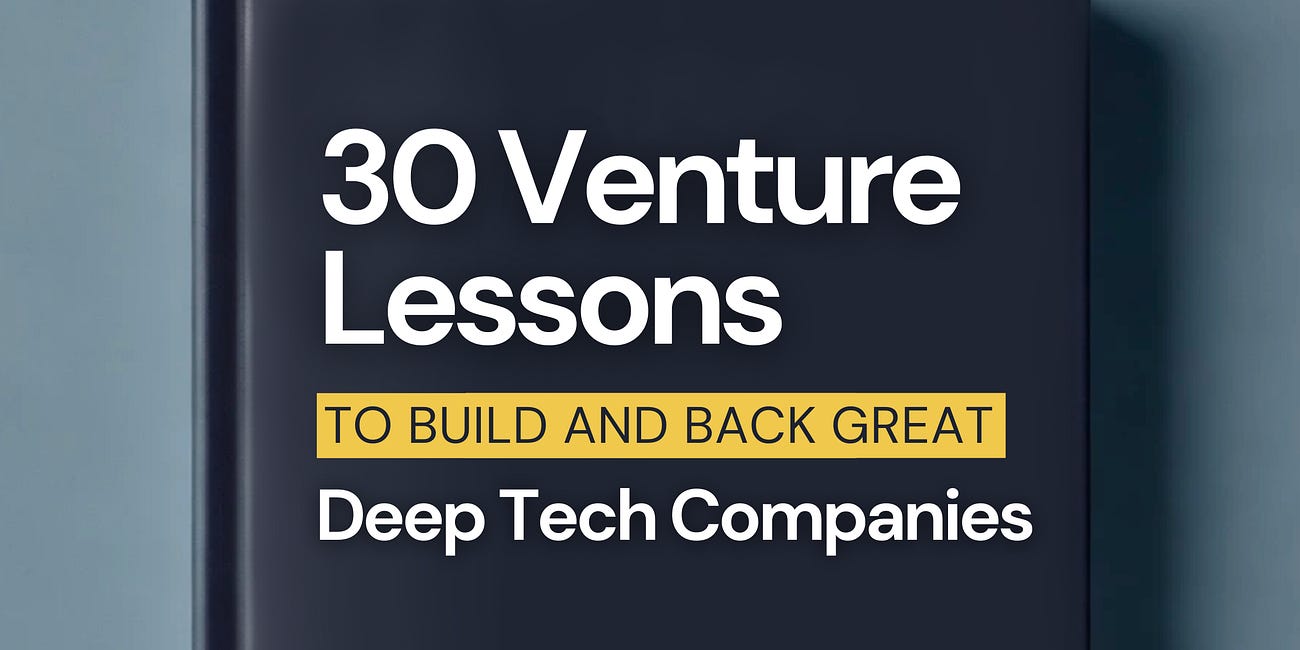Here’s What the Most Successful Deep Tech Teams Are Doing Differently
You Can’t Build Deep Tech With a SaaS Mindset...
You Can’t Build Deep Tech With a SaaS Mindset
Field notes for those building and backing deep tech ventures in 2025
There’s a familiar story playing out across labs and boardrooms.
A team of exceptional scientists, spinning out from top universities or R&D centers, raises their first round.
They’re tackling serious challenges—next-gen catalysts, sustainable materials, or breakthrough quantum processes.
The ambition is clear. The science is compelling.
The slide deck ends with “platform potential.”
Twelve to eighteen months later, the tone has shifted.
The update talks about “strategic pivots” or a “longer go-to-market path than anticipated.”
Often, the tech still holds promise.
But the runway is gone.
What happened?
More often than not, they followed the wrong map.
They borrowed assumptions from a world that doesn’t operate by the same physics—literally and figuratively.
Deep Tech Is Not SaaS
The startup world has spent 20 years optimizing for one model: fast, lean, digital, low-CAPEX, infinitely scalable.
That mindset created giants.
But it also created a blind spot.
Deep tech isn’t just “harder tech.”
It’s a different game entirely.
And too many founders—and investors—are realizing that only after burning through a runway built for a product that doesn’t live in the cloud.
Here’s what breaks when you try to build deep tech with a SaaS mindset:
1. Customer Discovery Doesn’t Work the Same
In SaaS, you can run 20 customer calls in a week, mock up an MVP in Figma, and test paywalled features by Friday.
You’re navigating known behaviors and predictable incentives.
In deep tech?
Your customer might be a procurement manager who’s never heard of your material.
Or an energy operator who’s three years away from trying anything new.
What matters isn’t what they say they want.
It’s how their supply chain works.
It’s what line item your solution replaces—and who has the authority to sign off.
This is not a “user persona.”
This is industrial anthropology.
2. You Don’t Sell the Solution — You Sell the Problem
The best SaaS startups obsess over UX.
The best deep tech startups obsess over pain.
You’re not selling your quantum coating.
You’re selling:
18% efficiency gains in a grid where every basis point counts
Compliance with PFAS bans that threaten $400M in SKUs
Sovereign independence from Chinese rare earths
If your pitch leads with your material, you’ve already lost.
Lead with the urgency.
3. The Laws of Scaling Are Inverted
In SaaS, scale lowers your marginal costs.
In deep tech, scale often reveals new problems:
The reaction works in the lab, but not at 500L
The material is stable for 2 weeks, but not 12 months
The pilot used purified feedstock—your customer doesn’t
You can’t “just scale” a novel process like it’s compute.
That’s why smart teams build scale into the R&D:
They start techno-economic modeling at TRL 3.
They involve manufacturing partners before Series A.
They raise enough to fail at scale—before betting the company.
4. The Wrong VCs Can Kill You
Here’s the uncomfortable truth:
Most VCs are still optimizing for software returns, on software timelines, with software instincts.
They’ll push you to ship faster, raise bigger, promise more.
But a materials venture that overpromises at Series A won’t make it to B.
Because no one wants to fund a 40% gross margin business with 7-year payback cycles—unless they understood that from Day 1.
Smart deep tech founders don’t just raise capital.
They curate it.
They find investors who know:
That revenue isn’t everything early on
That regulatory tailwinds matter more than ARR
That building a plant is not a pivot
5. Narrative Discipline Isn’t Optional
This might surprise you, but the best deep tech founders are also great communicators.
Not in the TED Talk sense—but in the “build belief” sense.
They know how to frame their venture as:
A wedge into a massive shift (like the Inflation Reduction Act or PFAS phaseouts)
A linchpin in a bigger supply chain reshuffle
A bet that must be made now, or someone else will
In a market where buyers are skeptical, timelines are long, and capital is constrained—narrative is leverage.
So What’s the Alternative?
If the SaaS mindset doesn’t work… what does?
Here’s what we’re seeing in the smartest teams today:
Co-development > stealth mode
They build with strategic partners from day one.Regulatory timing > “first to market”
They don’t just invent—they align with laws.Techno-economics > TAM slides
They model cost curves at the bench, not post-revenue.Pilot discipline > proof-of-concept theater
They pick pilots with scale logic, not logo appeal.Narrative clarity > hype cycles
They tell a story investors and customers can act on.
This isn’t easy.
It’s not fast.
But if you’re doing it right, you’re not just raising funds.
You’re reshaping industries.
Where to Go If You’re Actually Building This
If this resonates, it’s probably because you’ve already been in the room:
Trying to explain a materials breakthrough to a finance guy.
Or figuring out how to price something the world hasn’t seen before.
Or spending 9 months just to get a letter of intent from a partner who still needs 6 more approvals.
We get it—because we’ve spent the last year collecting the tools you wish you had in those moments.
We’ve spent hundreds of hours inside real deals—from founder debriefs to investor standoffs, from first pilots to million-dollar scale-ups, and hard-won lessons from people who usually don’t share what they know...
And we turned it all into a reference library.
Built to be used—not just read.
Here’s what’s inside:
Tactical breakdowns of how the best teams negotiate with industry giants
Frameworks to build traction when your product still lives in a lab
Deep dives into markets where $100B shifts are quietly happening under the radar
Lessons from founders who’ve actually raised, shipped, and scaled in deep tech—not in theory, but in practice
This is everything we’ve collected—So far.
And we’re not done….
✨ Here’s the Entire Collection:
The full collection is reserved for Premium Members of The Scenarionist.
The Scenarionist Premium is built to make you a sharper Deep Tech Founder, Investor, and Operator. Premium unlocks exclusive access to this one-of-a-kind collection—plus our weekly insight drops and Venture Guides that go deep where others skim.
30 Venture Lessons to Build and Back Great Deep Tech Companies
→ What You’ll Get:
A carefully curated and condensed list of the most valuable lessons we’ve learned about building and supporting early-stage Deep Tech startups—straight from the collective wisdom of 50+ global Deep Tech VCs, CVCs, and experts.
You’ll walk away with clear guidance on how to: • Frame your market so it resonates with non-technical investors
• Build the right founding team for high-risk, long-term ventures
• Avoid the common pitfalls of scaling scientific innovation too early—or too late
Whether you're refining your investment memo, prepping for a board update, or mapping out next year’s org chart, this is the reference you’ll want by your side.
The Next $100B Deep Tech Market No One Is Talking About
→ What you get:
A crystal-clear playbook for identifying and backing the breakout winners in the most underpriced frontier of deep tech: advanced materials.
You’ll learn how to:
• Spot which startups are building real industrial moats (not lab curiosities)
• Decode pilot-stage traction signals that actually predict scale
• Understand what corporate and defense buyers are already funding — and why
• Align your funding or operating strategy with trillion-dollar tailwinds (CHIPS Act, IRA, EU Green Deal)
• Avoid the classic pitfalls that kill materials ventures before they leave the lab
Whether you're scouting the next FlexGen or co-developing with Boeing, this is the edge that lets you operate—and invest—like the insiders who already moved in.
The Industrial Flywheel: How to Engineer Demand Before Building Your Factory | Chapter 1
→ What you get:
A tactical guide for industrial deep tech founders and backers who want to build pull, not just product.
You’ll learn how to:
• Generate industrial demand before spending a cent on capex
• Build market gravity through pilots, MOUs, and regulatory leverage
• Align your factory roadmap with actual buyer urgency (not wishful thinking)
• Turn pilot partners into future buyers — and exit enablers
• Structure early-stage teams that de-risk scale-up before the cement dries
This is for anyone who’s ever asked:
“Can we justify the build?”
This chapter helps you answer yes — with strategy, proof, and momentum
The Industrial Flywheel: How to Engineer Demand Before Building Your Factory | Chapter 2
→ What you get:
A step-by-step playbook for turning your deep tech pilot into an engine of investor confidence, customer traction, and scalable adoption.
You’ll learn how to:
• Design pilots that test real-world economics, not just lab performance
• Move beyond MoUs with partner-backed JDAs and offtake agreements
• Align pilot KPIs with the metrics decision-makers actually care about
• Use pilot data to unlock capital, trigger industrial buy-in, and de-risk the leap to scale
• Avoid the most common traps: overselling, under-integrating, over-customizing
This chapter is for founders and investors who don’t just want to prove a product — but engineer the tipping point for scale.
The Deep Tech Negotiation Playbook | Chapter 1/4
→ What you get:
A tactical field guide for Deep Tech founders raising capital in a world where science meets venture dynamics.
This chapter breaks down:
• Why capital is no longer scarce—but credibility is
• How to flip the pitch: lead with the problem, not just the tech
• What makes Deep Tech negotiations uniquely high-stakes (long cycles, binary risk, and IP tangles)
• How to frame your breakthrough as an investable business, not a thesis defense
• When to raise, with what kind of evidence, and how to pick the right fund
• The four elements investors actually want to hear (hint: not your entire patent history)
This is not just about raising capital—it's about structuring leverage, aligning incentives, and negotiating from a position of proof, not need.
The Deep Tech Negotiation Playbook | Chapter 2/4
→ What it is:
A surgical breakdown of the three negotiation levers that matter before you even open a term sheet:
✔️ Market validation
✔️ Team credibility
✔️ Technology readiness
Chapter 2 is your toolkit to:
• Show investors you’re not pitching science fiction—you’re solving urgent, expensive problems
• Use LOIs, pilot projects, and insider advisors to build leverage before the money talk
• Turn TRLs + techno-economic awareness into funding milestones
• Position your founding team as a competitive moat (not just a group of smart PhDs)
→ Why it matters:
Negotiation in Deep Tech isn’t a verbal duel. It’s a choreography of execution signals. This chapter teaches you to set the stage with hard proof—so that by the time investors show up, you control the narrative.
Bonus wisdom inside:
• Why top-down TAM slides kill deals
• Why NDA paranoia is self-sabotage
• Why the most dangerous investor question is: “Why you? Why now?”
• How a killer team slide turns silence into term sheets
The Deep Tech Negotiation Playbook | Chapter 3/4
What you get:
• How to frame ownership when all you have is vision, not revenue
• Why valuation in deep tech is a conversation, not a spreadsheet
• How to use comparables and milestones to shape your ask
• The truth about dilution—and how to use it as a strategic lever
• Cap table red flags that silently kill deals
• Why your exit strategy is the starting point, not the end
This isn’t a how-to guide. It’s a field manual for founders negotiating with nothing but a dream, a deck, and the grit to pull it off.
Chapter 4 is coming soon…
…and it’s the one you’ll want in your back pocket when you sit across the table. Tactical negotiation techniques, real-world founder playbooks, and how to own the room when the stakes are highest.
Stay tuned.













